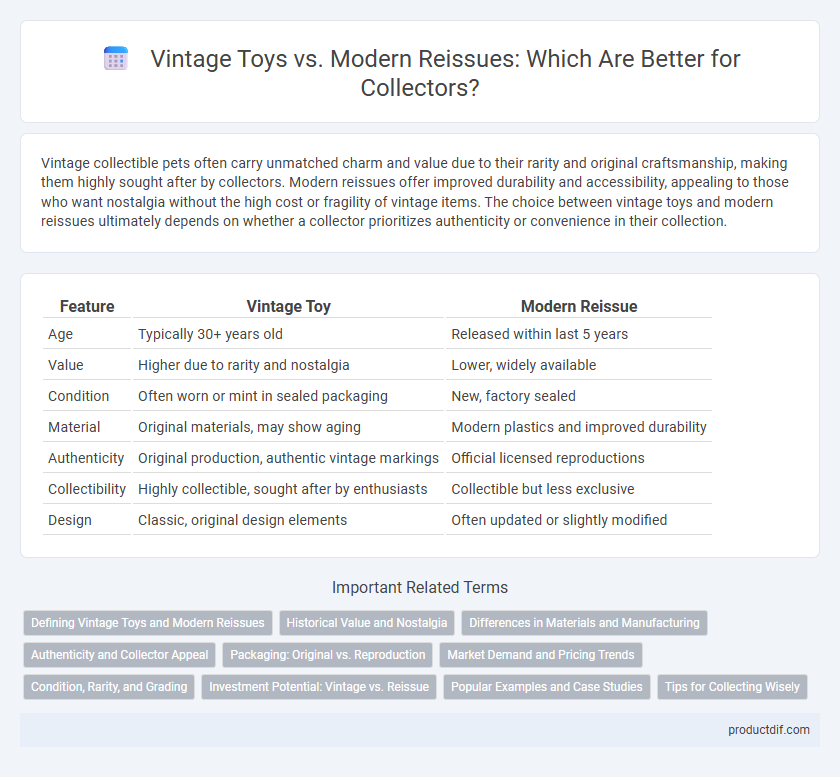Vintage collectible pets often carry unmatched charm and value due to their rarity and original craftsmanship, making them highly sought after by collectors. Modern reissues offer improved durability and accessibility, appealing to those who want nostalgia without the high cost or fragility of vintage items. The choice between vintage toys and modern reissues ultimately depends on whether a collector prioritizes authenticity or convenience in their collection.
Table of Comparison
| Feature | Vintage Toy | Modern Reissue |
|---|---|---|
| Age | Typically 30+ years old | Released within last 5 years |
| Value | Higher due to rarity and nostalgia | Lower, widely available |
| Condition | Often worn or mint in sealed packaging | New, factory sealed |
| Material | Original materials, may show aging | Modern plastics and improved durability |
| Authenticity | Original production, authentic vintage markings | Official licensed reproductions |
| Collectibility | Highly collectible, sought after by enthusiasts | Collectible but less exclusive |
| Design | Classic, original design elements | Often updated or slightly modified |
Defining Vintage Toys and Modern Reissues
Vintage toys are original items produced during a specific era, typically characterized by authentic materials, manufacturing techniques, and nostalgic value from past decades. Modern reissues replicate these classic toys using newer production methods and materials, often incorporating updated safety standards while striving to maintain the original design. Collectors differentiate vintage toys by their age, rarity, and historical significance compared to modern reissues, which appeal through accessibility and preserved aesthetics.
Historical Value and Nostalgia
Vintage toys carry unique historical value as authentic artifacts from their original era, often reflecting the culture and manufacturing techniques of the time. Their rarity and genuine wear add nostalgic appeal that modern reissues, despite high-quality replication, struggle to replicate fully. Collectors prioritize vintage toys for their provenance and emotional connection, making them more valuable in the collectible market.
Differences in Materials and Manufacturing
Vintage toys typically feature materials like metal, wood, and early plastics such as Bakelite, reflecting manufacturing techniques from the mid-20th century that often involved hand assembly and less precise molds. Modern reissues utilize advanced plastics, including ABS and PVC, produced through automated processes like injection molding, resulting in higher consistency and durability. The tactile quality and aging characteristics differ, with vintage toys showing patina and wear unique to older materials, while reissues maintain a newer appearance with synthetic finishes designed for longevity.
Authenticity and Collector Appeal
Vintage toys possess unmatched authenticity that modern reissues often lack, drawing collectors who prize originality and historical value. Modern reissues offer improved durability and accessibility but frequently struggle to capture the intricate details and patina that define vintage pieces. Authenticity significantly impacts collector appeal, with provenance and condition driving market demand and premium pricing for genuine vintage toys.
Packaging: Original vs. Reproduction
Original vintage toy packaging often features unique aging characteristics like yellowing, wear, and period-specific design elements, which significantly enhance collectible value over modern reissues. Reproduction packaging, while visually similar, lacks authentic aging cues and may use updated materials or printing techniques, reducing its desirability among serious collectors. The authenticity of original packaging directly impacts market prices, with sealed vintage toys often commanding premium prices far above their reissued counterparts.
Market Demand and Pricing Trends
Vintage toys consistently command higher market demand and premium pricing due to their rarity, nostalgic value, and historical significance among collectors. Modern reissues often attract casual buyers seeking affordability and accessibility but typically do not appreciate significantly in value over time. Collectible markets reveal that scarcity and original production era heavily influence pricing trends, with vintage toys outperforming reissues in long-term investment potential.
Condition, Rarity, and Grading
Vintage toys often command higher value due to original production scarcity, with pristine condition and certified grading significantly enhancing their market worth. Modern reissues, while more accessible and typically produced with improved materials, lack the inherent rarity and nostalgic authenticity that vintage pieces hold. Collectors prioritize condition grades such as Mint or Near Mint for vintage toys, as these ratings directly correlate with rarity and potential investment appreciation.
Investment Potential: Vintage vs. Reissue
Vintage toys generally hold higher investment potential due to their rarity, original manufacturing quality, and nostalgic value that appeals to seasoned collectors. Modern reissues often lack the same market value because they are mass-produced and do not possess the historical significance or unique imperfections found in vintage editions. Collectors seeking long-term appreciation prioritize vintage items for their authenticity and limited availability, which drive demand and increase prices over time.
Popular Examples and Case Studies
Vintage toys like original Star Wars action figures from the 1970s fetch high prices due to rarity and nostalgic value, whereas modern reissues such as LEGO Star Wars sets appeal to collectors with updated designs and improved materials. The resurgence of retro brands like Transformers demonstrates how modern reissues can revive interest while maintaining a connection to the original franchise. Case studies reveal that vintage items often outperform reissues in auction value, but modern collectibles sustain market demand by engaging new generations through enhanced features.
Tips for Collecting Wisely
When collecting vintage toys versus modern reissues, prioritize authenticity by researching specific manufacturing years, original packaging, and unique markings that distinguish genuine vintage items. Use trusted appraisal guides and consult online collector communities to assess condition and market value accurately. Focus on rarity and demand trends to make informed purchases that maximize investment potential.
Vintage Toy vs Modern Reissue Infographic

 productdif.com
productdif.com